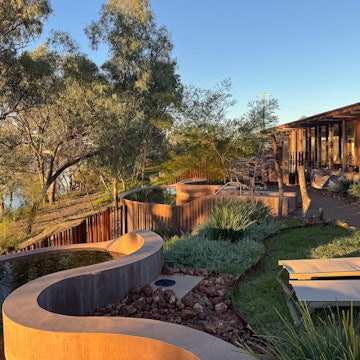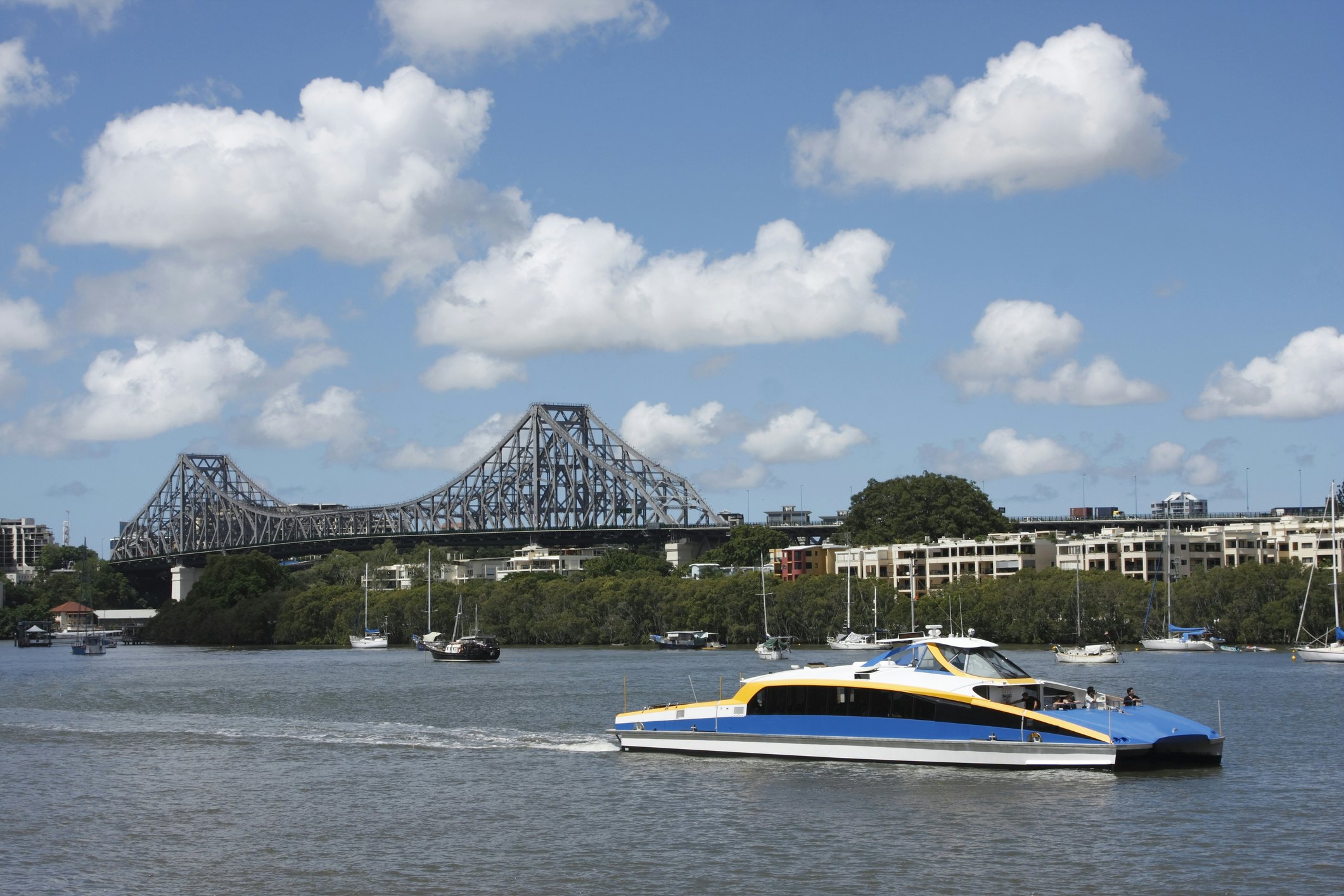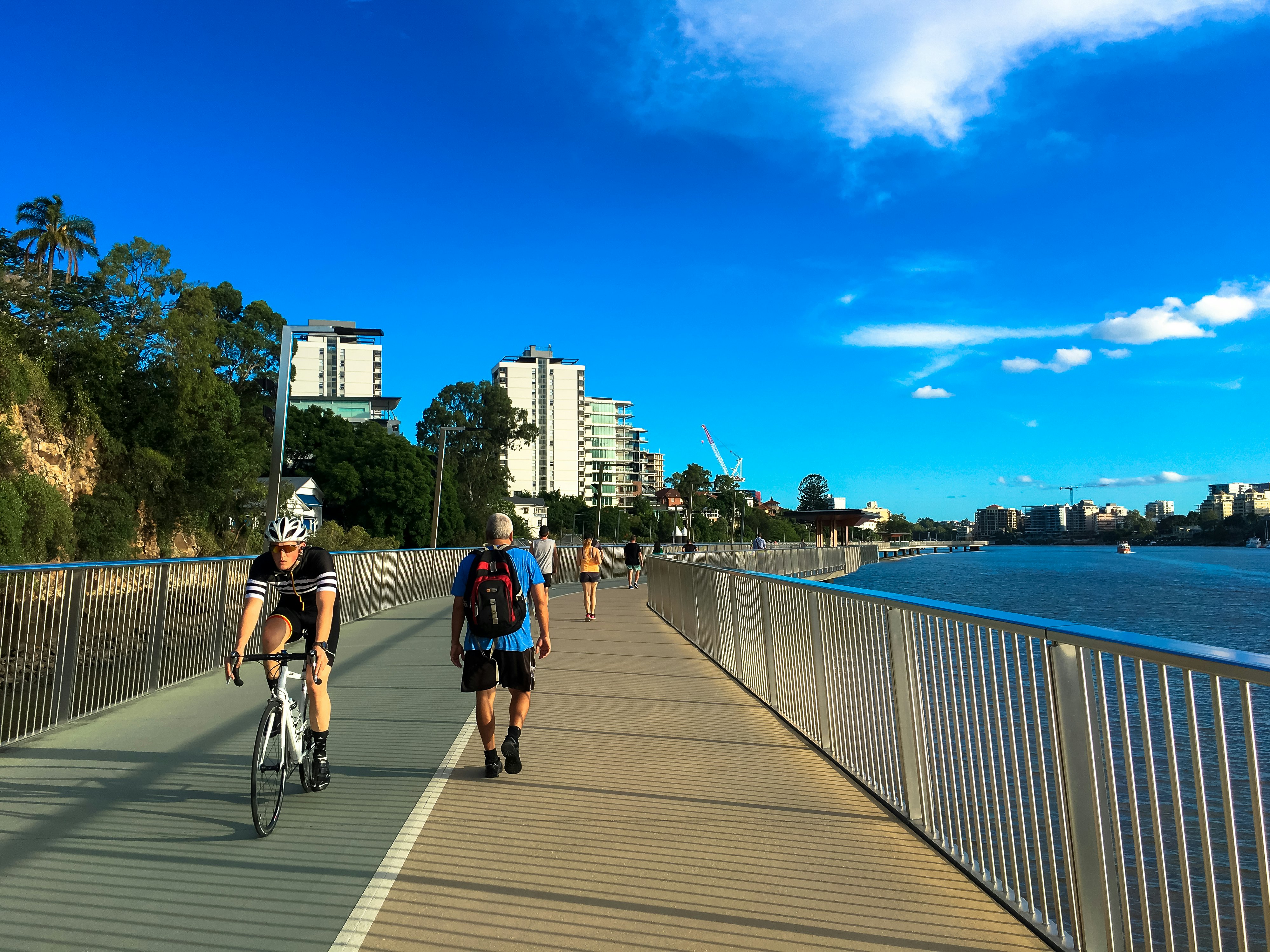
How to get around in Brisbane: the easiest, cheapest and most sustainable options

Nov 29, 2021 • 6 min read

The garden boardwalk in Brisbane's Southbank © Petronilo G. Dangoy Jr. / Shutterstock
While many Brisbanites drive from A to B, Brisbane’s integrated transport system and shared bike and pedestrian trails mean you don’t need a car to get around. The network reaches Brisbane’s best galleries, restaurants, bars and live-music venues, most of which are concentrated in the inner neighbourhoods of central Brisbane (the Central Business District or "CBD" for short), South Bank, West End, Fortitude Valley and Newstead.
Here’s everything you need to know about getting around Brisbane.
Zones, tickets & passes in Brisbane
TransLink oversees bus, train and ferry services in Brisbane. Download the MyTransLink app for its useful journey planner and timetables and check the website for network maps.
While there are eight travel zones, most cultural, dining and entertainment precincts lie in Zone 1. A single-ride paper ticket for Zone 1 is $4.90 ($2.40 for children aged 5 to 14) and allows unlimited transfers on buses, trains and ferries within two hours. Always pre-purchasetickets from ticket vending machines at train stations and major bus interchanges before travel.

The Brisbane Go Card
If you’re staying a few days, opt for an electronic Go Card (the starting balance is adult/child $10/5). Available from station ticket machines, 7-Eleven convenience stores and newsagents, the card covers all zones and shaves over 30% off individual trips. A further 20% is discounted for off-peak travel between 8.30am and 3.30pm and after 7pm on weekdays, as well as all day on weekends and public holidays. Children with a child Go Card travel free on weekends.
To use any Go Card, simply tap-on at the start of each trip and tap-off at the end of it. There’s no need to tap-off between trains if transferring at the same station.
Brisbane Airport’s two train stations also sell the tourist go seeQ Go Card, which offers unlimited travel over three or five days (adult $79 and $129 respectively; child $40 and $65).
Take the ferry for knockout "Brissy" views
Brisbane’s ferries are highlights in themselves, serving up Manhattan-esque cityscapes and providing a relaxing way to hop between riverside neighbourhoods.

The difference between the CityCat & the CityHopper ferry
CityCat catamarans are the largest and fastest of the fleet, serving 18 stops along the Brisbane River. Convenient stops include South Bank Terminals 1 and 2 (for South Bank Parklands, Queensland Art Gallery and Australia’s largest contemporary art museum, GOMA), QUT Gardens Point (for City Botanic Gardens), Riverside (for CBD waterfront dining) and New Farm Park (for arts center Brisbane Powerhouse and its Saturday morning farmers’ market).
Alight at Northshore Hamilton for popular street-food "village" Eat Street Northshore. CityCat services run every 15 to 30 minutes from around 5am to around 11pm (midnight on Fridays and Saturdays).
CityHopper ferries are slower and serve less stops, but they’re free to ride, so if you’re on a tight budget, hop on and enjoy the views between South Bank and New Farm. CityHoppers sail every 30 minutes from about 6am to around midnight.
Walk Brisbane's neighbourhoods
While public transport is convenient for travelling between suburbs, drawcards within individual neighbourhoods are generally concentrated on a few streets, such as Boundary Street in indie-hearted West End and Ann, Brunswick and James Streets in nightlife hub Fortitude Valley. This makes walking ideal (especially hot, humid summer days aside).
The Kurilpa, Victoria and Goodwill Bridges provide pedestrian access between the CBD and South Bank’s museums, galleries and theatres. From here, West End is an easy 10 to 15 minute walk along Melbourne Street. The Brisbane River itself is flanked by kilometres of beautiful pedestrian and cycling trails. Among these is the 870-metre Brisbane Riverwalk, built directly over the water. Don’t forget your sun hat and SPF 50+ sunscreen!

Cycle on the waterfront
Cycling Brisbane’s dedicated riverside trails is another fantastic way to soak up those subtropical vibes, whether you’re peddling from the City Botanic Gardens to Kangaroo Point via the Go Between Bridge, or from Howard Smith Wharves to Teneriffe via the Brisbane Riverwalk (with a short detour through New Farm’s leafy side streets).
The Brisbane City Council’s online Cycling Brisbane Bikeway Map marks on- and off-road routes, bike repair shops, bike parking and (importantly!) water fountains to get re-hydrated.
Neuron Mobility e-bikes and e-scooters are littered across the city; to use one, download the Neuron app, register your details and search for nearby e-bikes and e-scooters using the real-time locater. Rates range from "pay per ride" ($1 to unlock, then $0.45 per minute) to multi-day passes (a three-day pass costs $8.33 per day and allows 90 minutes of daily use). You pay via the app.
Beam also provides e-bikes and e-scooters; download the Beam app for details. For longer cycles, Riverlife offers better value, with standard adult and kids’ bikes costing $25 per day.
Note that riding on main streets without dedicated bike lanes can be stressful and potentially dangerous. Stick to cycle lanes, car-free trails and quieter side streets. It's also wise to avoid cycling in the middle of hot days in Australia.
Brisbane by bus
Brisbane buses reach all corners of the city, running every five to 30 minutes from around 5.15am till about 11pm. NightLink services run all night Fridays and Saturdays.
Major interchange stops include the Queen Street and King George Square Bus Stations in the CBD and the Cultural Center stop in South Bank. A large number of routes reach Woolloongabba (home of the Gabba cricket ground), while route 375 saves you the uphill walk to inner-city Paddington and its boutiques, antique shops and cafes.
Buses are also useful for reaching the bookshops and pubs of West End; routes 60, 196 and 199 connect West End to Fortitude Valley and Newstead, the latter home to live-music venue The Triffid and lauded microbreweries Range Brewing and Green Beacon.

Take the train between South Bank & The Valley
All six of Brisbane’s suburban train lines connect the CBD stations of Central and Roma Street to Fortitude Valley. Three of the lines (Ferny Grove and Beenleigh, Shorncliffe and Cleveland, Airport and Gold Coast) also stop at South Brisbane and South Bank stations, making them handy if heading out in "The Valley" after sightseeing in South Bank. Trains run from around 4.30am, with the last train on most lines leaving Central between 11pm and 1am.
Taxis & ridesharing
Taxis can be hailed at ranks, on the street, or using the Black & White and 13cabs taxi apps. Flagfall starts at $2.90 and is more expensive after 7pm and on weekends. NightLink flat-fare taxis run on Friday and Saturday nights (11pm to 5am) and can be hailed from dedicated ranks in the CBD and Fortitude Valley. These often work out cheaper than standard taxis.
Ride-sharing services include Uber, DiDi, Ola and Shebah; the latter operates an all-female fleet of drivers offering rides for women and children.
Accessible transportation in Brisbane
Brisbane is generally accessible for travellers with disabilities. All city buses, trains and CityCat catamarans accommodate wheelchairs and mobility scooters, as do major attractions. CityHopper ferries, however, do not. For more information, including a list of accessible train stations and ferry stops, see the Translink website.
You might also like:
The 6 best day trips from Brisbane
5 reasons to visit Brisbane right now
5 brilliant beaches near Brisbane












